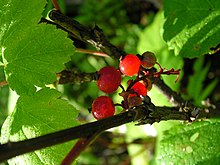Ribes triste
| Ribes triste | |
|---|---|

| |

| |
| Scientific classification | |
| Kingdom: | Plantae |
| Clade: | Tracheophytes |
| Clade: | Angiosperms |
| Clade: | Eudicots |
| Order: | Saxifragales |
| Family: | Grossulariaceae |
| Genus: | Ribes |
| Species: | R. triste
|
| Binomial name | |
| Ribes triste | |
| Synonyms[1] | |
| |
Ribes triste, known as the northern redcurrant,[2] swamp redcurrant, or wild redcurrant,[3] is an Asian and North American shrub in the gooseberry family. It is widespread across Canada and the northern United States, as well as in eastern Asia (Russia, China, Korea, Japan).[4][5]
Ribes triste grows in wet rocky woods, swamps, and cliffs. It grows to 50 cm (20 in) tall, with a lax, often creeping branches. The leaves are alternate, palmately lobed with five lobes, 6–10 cm (2+1⁄4–4 in) in diameter. The flowers are in pendulous racemes, 4–7 cm (1+1⁄2–2+3⁄4 in) long. The axis of the raceme is glandular. Each raceme bears 6-13 small, purplish flowers that appear in June and July. The fruit is a bright red berry, without the hairs that some currants have. The fruit is edible but rather sour.[6]
Conservation status in the United States[edit]
It is listed as endangered in Connecticut[7] and Ohio, and as threatened in Pennsylvania.[8]
As a weed[edit]
Ribes is listed a plant pest in Michigan and the planting of it in certain parts of the state is prohibited.[8]
Use by Native Americans[edit]
In cuisine[edit]
Alaska Natives use the fruit as food, eating it raw, and making the berries into jam and jellies.[9] Eskimos eat the berries[10] and the Inupiat eat them raw or cooked, mix them with other berries which are used to make a traditional dessert. They also mix the berries with rosehips and highbush cranberries and boil them into a syrup.[11] The Iroquois mash the fruit, make them into small cakes, and store them for future use. They later soak the fruit cakes in warm water and cooked them a sauce or mixed them with corn bread. They also sun dry or fire dry the raw or cooked fruit for future use and take the dried fruit with them as a hunting food.[12] The Ojibwe eat the berries raw, and also preserve them by cooking them, spreading them on birch bark into little cakes, which are dried and stored for winter use.[13] In the winter, they often eat the berries with cooked with sweet corn. They also use the berries to make jams and preserves.[14] The Upper Tanana eat the berries as food.[15]
In medicine[edit]
The Ojibwe take a decoction of the root and stalk for 'gravel',[16] and take a compound decoction of the stalk for 'stoppage of periods',[17] and use the leaves as a 'female remedy'.[18] The Upper Tanana use a decoction of the stems, without the bark, as a wash for sore eyes.[15]
References[edit]
- ^ "Ribes triste". Tropicos. Missouri Botanical Gardens – via The Plant List. Note that this website has been superseded by World Flora Online
- ^ Ulev, Elena D. (2006). "Ribes triste". Fire Effects Information System (FEIS). US Department of Agriculture (USDA), Forest Service (USFS), Rocky Mountain Research Station, Fire Sciences Laboratory.
- ^ "Ribes triste Pall., swamp red currant, wild red currant". Canada's Plant Hardiness Site. Natural Resources Canada.
- ^ "Ribes triste". State-level distribution map from the North American Plant Atlas (NAPA). Biota of North America Program (BONAP). 2014.
- ^ Lu, Lingdi; Alexander, Crinan. "Ribes triste". Flora of China. Vol. 8 – via eFloras.org, Missouri Botanical Garden, St. Louis, MO & Harvard University Herbaria, Cambridge, MA.
- ^ Morin, Nancy R. (2009). "Ribes triste". In Flora of North America Editorial Committee (ed.). Flora of North America North of Mexico (FNA). Vol. 8. New York and Oxford: Oxford University Press – via eFloras.org, Missouri Botanical Garden, St. Louis, MO & Harvard University Herbaria, Cambridge, MA.
- ^ "Endangered, Threatened, and Special Concern Plants". State of Connecticut Department of Energy and Environmental Protection Bureau of Natural Resources. Retrieved 28 December 2021. (Note: This list is newer than the one used by plants.usda.gov and is more up-to-date.)
- ^ a b USDA, NRCS (n.d.). "Ribes triste". The PLANTS Database (plants.usda.gov). Greensboro, North Carolina: National Plant Data Team. Retrieved 24 January 2018.
- ^ Heller, Christine A. (1953). Edible and Poisonous Plants of Alaska. University of Alaska. p. 87.
- ^ Anderson, J. P. (1939). "Plants Used by the Eskimo of the Northern Bering Sea and Arctic Regions of Alaska". American Journal of Botany. 26 (9): 715. doi:10.1002/j.1537-2197.1939.tb09343.x.
- ^ Jones, Anore (1983). Nauriat Niginaqtuat = Plants That We Eat. Kotzebue, Alaska: Maniilaq Association Traditional Nutrition Program. p. 105.
- ^ Waugh, F. W. (1916). Iroquis Foods and Food Preparation. Ottawa: Canada Department of Mines. p. 128.
- ^ Densmore 1928, p. 321.
- ^ Smith 1932, p. 410.
- ^ a b Kari 1985, p. 11.
- ^ Densmore 1928, p. 348.
- ^ Densmore 1928, p. 358.
- ^ Smith 1932, p. 389.
Bibliography[edit]
- Densmore, Frances (1928). "Uses of Plants by the Chippewa Indians". SI-BAE Annual Report. 44.
- Smith, Huron H. (1932). "Ethnobotany of the Ojibwe Indians". Bulletin of the Public Museum of Milwaukee. 4.
- Kari, Priscilla Russe (1985). Upper Tanana Ethnobotany. Anchorage: Alaska Historical Commission.
